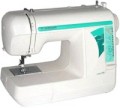Number of stitches
The number of stitches that a sewing machine can sew. The larger this number, the more extensive the capabilities of this model, the wider the choice the user has; however, it wouldn’t hurt to clarify the specific range of supported stitches separately.
The fewest options - mostly up to 25 - are provided in electromechanical machines, as well as specialized devices such as overlockers and carpet lockers (see “Type”). In computer-controlled devices, the number of lines can be in the dozens, and some also allow you to download additional options from the computer.
Max. stitch length
The maximum stitch length that the sewing machine can sew. This parameter is important for working with dense thick fabrics: the stronger the fabric, the longer the seam used for it. Accordingly, the longer the stitch (
5 mm or more), the better the machine is suitable for working with similar fabrics.
Max. presser foot height
It is the distance from the work surface to the presser foot in the highest position. It must be taken into account when working with thick fabrics.
Adjustments
—
Presser foot pressure adjustment. The ability to change the degree of pressure of the foot on the fabric, adjusting it to the thickness of the material: for thin fabrics (chiffon, knitwear), the pressure should be small, for thick ones — on the contrary.
—
Thread tension regulator. A device that allows you to adjust the degree of tension of the upper thread. A mismatch in tension between the top and bottom threads causes one of the threads to pull the other and the seam deteriorates. To avoid this phenomenon, this function is provided. Note that tension adjustment is also possible for the lower thread — it is carried out through the shuttle (all shuttles have this option). But for this, it is necessary to remove the bobbin case or even the entire shuttle. The top regulator is located directly on the body of the machine, and it is much easier to use it.
—
Puncture force stabilizer. A device that provides a stable puncture force regardless of the engine speed. A feature of the mechanics of electric motors is that without special adjustment, the puncture force decreases markedly with an increase in speed. This function allows you to maintain approximately the same level over the entire speed range, which has a positive effect on the quality of work.
—
Feed shutdown. Possibility to turn off the bottom feed of the
...machine. This feature is indispensable for work in which the fabric needs to be shifted manually — for example, embroidering along a complex contour on a typewriter without an embroidery unit, sewing on buttons, etc.
— Speed control. The ability to set a speed limit for the machine. Thanks to this function, you can not be afraid to "squeeze" the pedal — even with strong pressure, the machine will work at a given speed, and no faster. This feature is useful, in particular, in jobs where you need to carefully control the process.
— Knee lever. A device that allows you to raise the presser foot and lower the lower feed dog with a knee movement without removing your hands from the fabric. Such a device is useful for quilting and some types of embroidery.Power consumption
The power consumed by the machine during operation. Usually, the maximum power value is indicated in the characteristics.
Most of the electricity supplied to the machine is consumed by the engine, so this indicator primarily describes the power of the engine. The higher this power, the faster the machine can work and the better it is suitable for working with dense fabrics. However, there is no strict dependence here, much also depends on the general specialization of the unit.
Cover
The type of cover supplied with the sewing machine.
-
Soft. A soft fabric cover protects the machine mainly from dust and dirt and provides almost no protection from bumps and collisions. At the same time, having removed such a cover for the duration of work, it can be folded compactly.
-
Hard. A cover in the form of a hard cover put on from above or a case in which the machine fits. Such a cover is rather bulky, it cannot be folded like a soft one; on the other hand, it protects the machine well both from dirt and from collisions and contact with solid objects.

